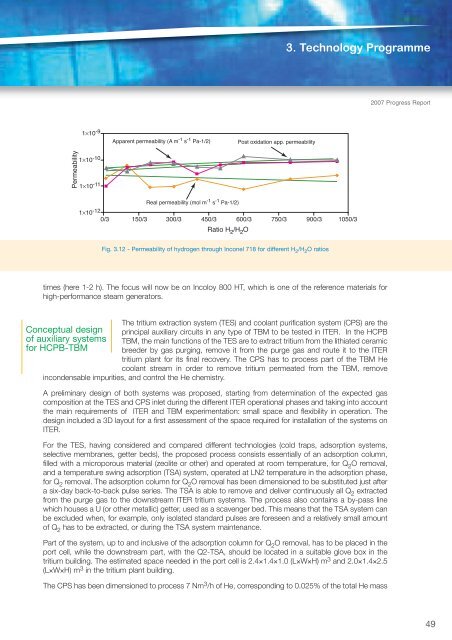<strong>Fusion</strong> <strong>Programme</strong>The second year of activitiesTechnologies of on the development andtritium extraction testing of systems forfrom Pb-16Li extracting tritium fromPb–16Li was dedicated tothe commissioning phase ofthe TRIEX loop, testing and qualifying the maincomponents and trying, at the same time, tosolve the hydraulic instabilities previouslydetected.At the same time, a sensor for operation inTime (min.)Pb–16Li molten alloy was designed, constructedand tested. The instrument is based on the Fig. 3.11 - Hydrogen sensor in Pb-16Li: comparisonprinciple of gas permeation, which is a between simulation and experimental resultscomponent of basic importance for TRIEX as wellas for the HCLL-TBM system. It consists of ahollow capsule of pure ARMCO iron, whose geometry was optimised on the basis of the latestdevelopments. Before installation in the TRIEX facility, the sensor was qualified in gas and liquid metalphases in an ad hoc device constructed at <strong>ENEA</strong> Brasimone. Tests on three hydrogen sensors (indicatedas PE1, PE2, PE3 in figure 3.11) consisted of• performance analysis in gas phase at operational temperature (450°C) and H 2 partial pressure of690 mbar;• compatibility study in lead alloy at operational temperature to verify the structural integrity of the sensorsafter exposure to a liquid metal environment.Discrepancies between the pressure evolutions of PE1, PE2 and PE3 and between experimental andsimulation results (fig. 3.11) could probably be attributed to the formation of a superficial oxide layer orslight differences in the permeation wall thickness. On the other hand, endurance tests in Pb-16Li alloyshowed that the sensors were able to maintain their structural integrity. Therefore, it can be concluded thatpermeation sensors in Pb-16Li appear suitable for measuring the hydrogen isotope concentration inPb–16Li at steady state in the TRIEX loop and, once implemented and optimised, in DEMO. However, suchtechnology has to be greatly improved for dynamic hydrogen isotope measurement, as required in the ITERenvironment. To cope with the HCLL-TBM requirement of strongly decreasing the measurement timeconstant (order of magnitude of ten seconds), modifications to the sensor design (geometry as well asmaterials used) are under investigation.Pressure (Pa)6500055000450003500025000150005000T(permeation=450°C)69000 Pa simulationPE1PE2PE300 100 200 300 4002007 Progress ReportExperimental study onefficiency of oxide layersfor tritium permeationreduction throughEUROFER and heatexchanger materials(Incoloy, Inconel)The aim of the activity, which is important for the design of DEMO, is toinvestigate the performance of natural oxides nucleated on differentstructural materials as tritium permeation barriers. After the experimentalcampaign carried out on EUROFER steel as candidate material for theblanket cooling plates, the same type of investigation was performed onInconel 718, which is a possible material for the steam generator in DEMO.In the explored range, 3-300 of H 2 /H 2 O molar ratio, no appreciable effectson the reduction in hydrogen permeation rate were found (fig. 3.12).Recent experiments performed by other researchers on the oxidation ofInconel 718 and its effect on crack growth demonstrated that nickel does not react with oxygen even athigh temperature, while iron and chromium can react, albeit with slow kinetics. It appears likely that thehigh concentration of nickel in this alloy blocks the formation of a stable oxide, at least for short exposition48
3. Technology <strong>Programme</strong>2007 Progress Report1×10 -9Apparent permeability (A m -1 s -1 Pa-1/2)Post oxidation app. permeabilityPermeability1×10 -101×10 -11Real permeability (mol m -1 s -1 Pa-1/2)1×10 -12 0/3 150/3 300/3 450/3 600/3 750/3 900/3 1050/3Ratio H 2 /H 2 OFig. 3.12 - Permeability of hydrogen through Inconel 718 for different H 2 /H 2 O ratiostimes (here 1-2 h). The focus will now be on Incoloy 800 HT, which is one of the reference materials forhigh-performance steam generators.The tritium extraction system (TES) and coolant purification system (CPS) are theConceptual design principal auxiliary circuits in any type of TBM to be tested in ITER. In the HCPBof auxiliary systems TBM, the main functions of the TES are to extract tritium from the lithiated ceramicfor HCPB-TBM breeder by gas purging, remove it from the purge gas and route it to the ITERtritium plant for its final recovery. The CPS has to process part of the TBM Hecoolant stream in order to remove tritium permeated from the TBM, removeincondensable impurities, and control the He chemistry.A preliminary design of both systems was proposed, starting from determination of the expected gascomposition at the TES and CPS inlet during the different ITER operational phases and taking into accountthe main requirements of ITER and TBM experimentation: small space and flexibility in operation. Thedesign included a 3D layout for a first assessment of the space required for installation of the systems onITER.For the TES, having considered and compared different technologies (cold traps, adsorption systems,selective membranes, getter beds), the proposed process consists essentially of an adsorption column,filled with a microporous material (zeolite or other) and operated at room temperature, for Q 2 O removal,and a temperature swing adsorption (TSA) system, operated at LN2 temperature in the adsorption phase,for Q 2 removal. The adsorption column for Q 2 O removal has been dimensioned to be substituted just aftera six-day back-to-back pulse series. The TSA is able to remove and deliver continuously all Q 2 extractedfrom the purge gas to the downstream ITER tritium systems. The process also contains a by-pass linewhich houses a U (or other metallic) getter, used as a scavenger bed. This means that the TSA system canbe excluded when, for example, only isolated standard pulses are foreseen and a relatively small amountof Q 2 has to be extracted, or during the TSA system maintenance.Part of the system, up to and inclusive of the adsorption column for Q 2 O removal, has to be placed in theport cell, while the downstream part, with the Q2-TSA, should be located in a suitable glove box in thetritium building. The estimated space needed in the port cell is 2.4×1.4×1.0 (L×W×H) m 3 and 2.0×1.4×2.5(L×W×H) m 3 in the tritium plant building.The CPS has been dimensioned to process 7 Nm 3 /h of He, corresponding to 0.025% of the total He mass49













